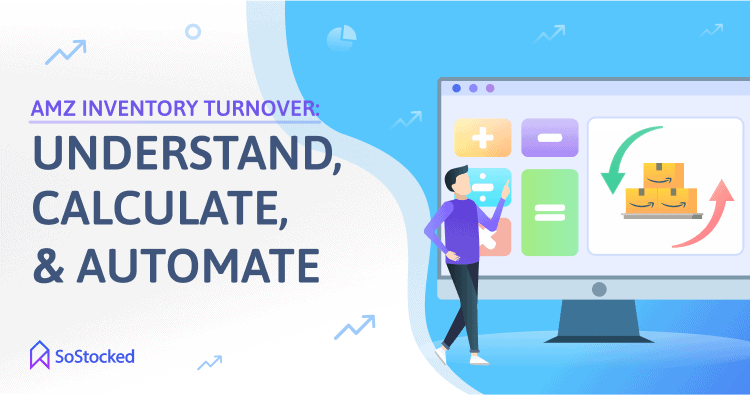
Amazon Inventory Turnover: Understand, Calculate, and Automate
An efficient inventory management system forms the backbone of any retail business. Without it, you’ll have a hard time keeping your stock levels within the optimal range.
When you stock out or carry excess stock, you spend a significant amount of cash on rush fees, air shipments, and holding costs, resulting in lost income.
In contrast, efficient sellers know how to maintain healthy stock levels and sell that stock fast, thereby filling their warehouses with fresh inventory regularly.
So, how do you know you’re not letting your merchandise gather dust in your warehouse or reordering inventory too often? One way to measure your success in managing inventory is in the financial metric called inventory turnover, also known as sell-through or inventory turn.
Let’s take a look at inventory turnover, along with some tips to maintain a good Inventory Turnover Ratio (ITR)
In this Amazon Inventory Turnover guide, we’ll take a look at:
- What Is Inventory Turnover?
- Why Is Inventory Turnover Important?
- How To Calculate Inventory Turnover Ratio?
- Benchmarking: What Is A Good Inventory Turnover Ratio?
- Differences In Inventory Turnover By Industry
- 7 Causes Of Low Amazon Inventory Turnover Ratio
- How To Increase Your Inventory Turnover Ratio
- Improve Your Inventory Turnover Ratio With SoStocked
- Convert Inventory Into Cash Frequently
What Is Inventory Turnover?
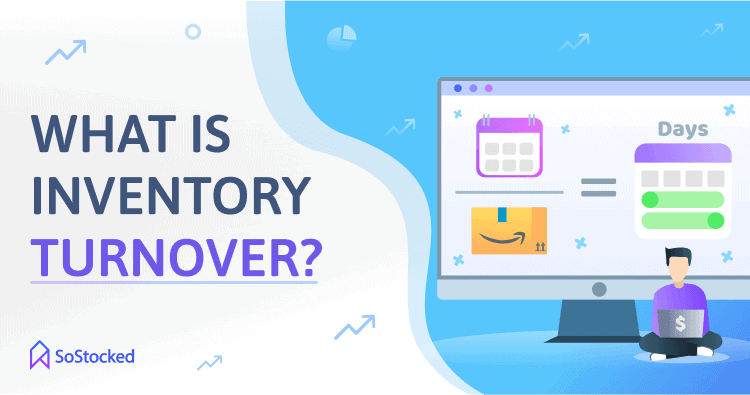
Inventory turnover refers to the rate at which you sold out an inventory order over time. One turn indicates one batch of inventory you’ve sold and replaced during a particular period.
A standard industry practice is to calculate ITR based on a 365 day period. However, the ideal inventory turnover rate may vary by industry. A ratio of 5 may be too high for discount retailers but too low for car companies. A good rule of thumb for most industries is to keep the ITR between 5 and 10. This ratio suggests that a company sells and restocks its inventory every 30 to 60 days.
A ratio of 5 would mean that you sold through and restocked your inventory 5 times that year. Similarly, 10 means you sold through 10 times in the year.
The formula to calculate how often that is can be looked at in this way:
ITR Formula
Number of days in a year or other period ÷ Number of times you turned over inventory = Number of days it takes to sell through your entire order
Example:
365 days ÷ 5 turns = sell-through every 73 days
Another example:
365 days ÷ 10 turns = sell-through every 36.5 days
However, ITR is not to be confused with your FBA sell-through rate, though they are quite similar in concept. While inventory turnover ratio generally uses 365 days, sell-through rate usually uses smaller increments of time such as a month.
One of the key metrics Amazon uses is sell-through rate which you are likely more familiar with and why all this may sound like something you’ve heard before.
In sell-through, Amazon doesn’t use 365 days to calculate. But, interestingly, it doesn’t use a monthly calculation either. Amazon uses a rolling 90 days.
On Seller Central, Amazon’s sell-through calculation reads:
“Your FBA rolling 90-day sell-through rate is the number of your units sold and shipped over the past 90 days divided by the average number of units available at fulfillment centers during that time.”
This is a very different calculation than what we are talking about with inventory turnover ratio.
While this isn’t a conversation around sell-through on Amazon, it is important to understand that distinction so things are clear moving forward.
To continue, if your products end up sitting in your warehouse for months, it means you don’t have an efficient inventory management process that prevents you from over-ordering, overestimating demand, and ordering products your customers don’t want to buy. Is your 3PL inventory tracking system missing inventory in its reports to you, causing you to over-order inventory? Have you ordered products that are hot-selling now, then obsolete later? Is lack of proper market or product research over-inflating buyer demand?
Similarly, restocking too late is not good, either. It’s often the result of under-estimating the demand for your product. Basing your demand forecasts around inaccurate data increases your risk for stockouts, which means lost income and increased operational costs.
Overall, your inventory turnover ratio reflects your capability to turn inventory into sales in a given period. It also provides insights into specific areas of your business that may need improvement, including:
- Cash flow management
- Reordering processes
- Forecasting
- Marketing and advertising
Pro Tip: Use a customizable inventory forecasting software to anticipate demand accurately. Such a program will allow you to adjust your daily sales velocity, factor in seasonality, marketing plans, and future growth. More importantly, you can remove sales spikes or stockout days to generate the most accurate forecasts possible, preventing you from over-ordering or under-ordering again.
Try SoStocked today!
Why Is Inventory Turnover Important?
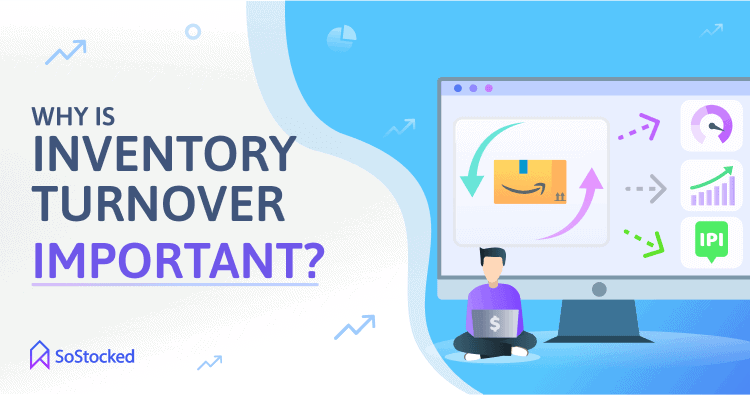
Below are the top three reasons why you should pay attention to your inventory turnover ratio.
Measures company performance
Calculating your inventory turnover ratio shows how efficient you are at converting products into sales. And therefore, generate the much-needed cash to pay suppliers, staff, logistics partners, etc. The quicker you replenish stock, the faster you can get that ROI working for your business again.
Improves business liquidity and efficiency
Inventory turnover helps you assess several parts of your Amazon business that have low or high ITR. Once you become aware of this fact, you can start taking action immediately. If your sell-through is too high, maybe you’re restocking too often and could save on shipping costs by ordering large orders less frequently. Too low, you probably have too many slow-selling products that you need to get rid of as soon as possible, i.e., put them on sale or sell them to liquidation companies.
Provides insights into your Amazon IPI score
Think of your ITR as a sneak peek into your Amazon IPI score. Amazon’s IPI algorithm factors excess inventory and sell-through rate into its scoring, which is very similar to how we look at inventory turnover ratios. So, if your products are not selling well, it may manifest as a low IPI score.
How To Calculate Inventory Turnover Ratio?
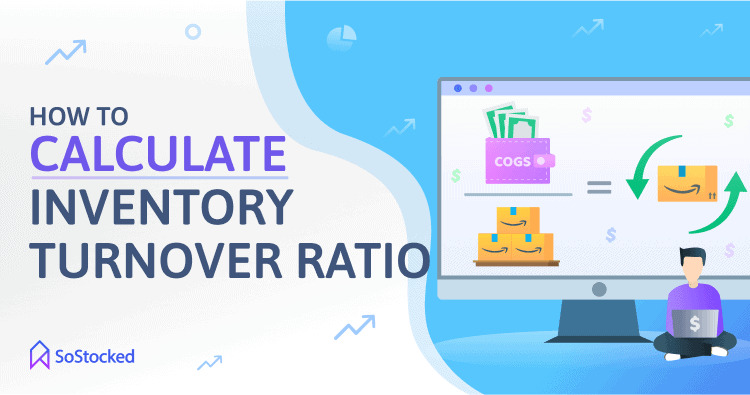
You can calculate your inventory turnover ratio by dividing the Cost of Goods Sold (COGS) by average inventory.
What is COGS?
COGS, also known as the cost of goods sold, is the amount of money you spend to turn an inventory into a finished product or sale. These costs typically include costs to procure raw materials, labor costs for producing your inventory, and other costs involved in shipping and sometimes even marketing the finished product.
To figure out your COGS, use this formula:
COGS Formula
Beginning Inventory + Purchases During Period – Ending Inventory = COGS
COGS Example
$25,000 + $146,000 – $21,000 = $150,000
Next, calculate your average inventory. Average inventory can be calculated by getting the average of the beginning and ending values.
Average Inventory Formula
(Beginning Inventory + Ending Inventory) ÷ 2 = Average Inventory
Average Inventory Example
($25,000 + $21,000) ÷ 2 = $23,000
Once you’ve determined COGS and Average inventory, divide them to calculate your inventory turnover ratio (ITR).
Inventory Turnover Ratio Formula
COGS ÷ Average Inventory = Inventory Turnover Ratio
Inventory Turnover Ratio Example
$150,000 ÷ $23,000 = 6.5
The inventory turnover ratio for the example above is 6.5. Since the result is within the ideal ratio for most industries, it indicates that the company strives to balance ordering enough inventory and not restocking too often.
Another way to calculate your Amazon inventory turnover ratio is by using the Days Sales of Inventory (DSI) method.
Days Sales of Inventory Ratio
DSI is a measure of the number of days it takes for inventory to turn into final sales. This is what we mentioned above but we will get into more specifics here. DSI is usually calculated by:
Average Inventory Formula
(Average Inventory ÷ COGS) x 365 = DSI
Average Inventory Formula Example
($23,000 ÷ $150,000) x 365 = 56 days
A lower DSI ratio indicates that an Amazon seller needs fewer days to turn inventory into sales. However, similar to the COGS method, the ideal DSI rates can differ by industry. So it’s good practice to compare your DSI with other companies in your industry.
Additionally, your DSI, turnover and sell-through can all be adjusted by adjusting your order quantities and order frequencies as well as improving your marketing efforts. As you work with these various factors, you will begin to recognize the relationships between these various metrics and how to affect them.
Benchmarking: What Is A Good Inventory Turnover Ratio?
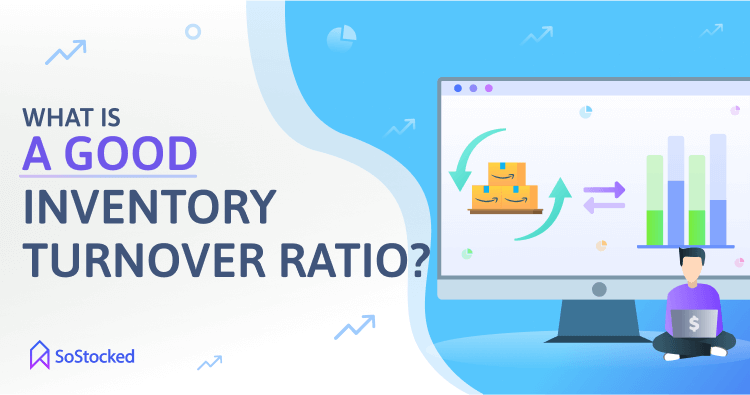
Companies use inventory turnover to analyze the speed at which they convert inventory into cash. Ideally, you’ll want to have a higher ITR as it indicates better performance and more frequently turning your inventory, whereas lower sell-through means inefficiency and less turns.
However, an abnormally high ITR may mean selling out faster than anticipated, resulting in inventory shortage or increased shipping costs due to smaller, more frequent orders. When you run out of stock, the product becomes unavailable to customers, and this ultimately leads to lost revenue.
Therefore, it’s best to compare your ITR against industry benchmarks to assess your company’s efficiency in managing inventory accurately.
Differences In Inventory Turnover By Industry
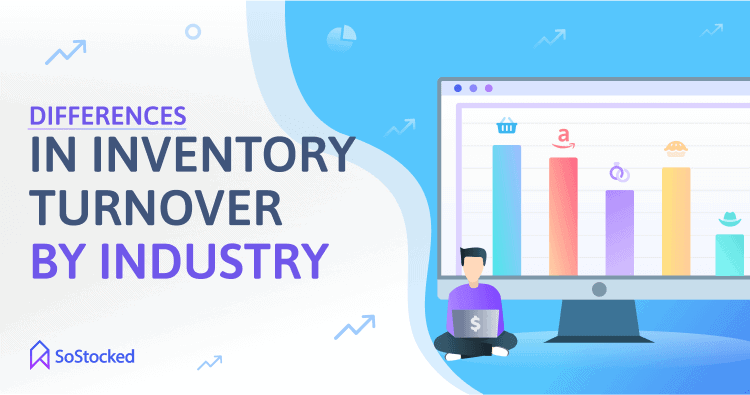
The type of industry has a direct influence on what will be your optimal ITR. It’s primarily because of the nature of the markets and products available. Let’s look at a couple of situations in which your industry can influence your ideal stock turnover ratio.
Grocery stores
Retail companies like grocery stores need to move their inventory quickly to maintain a high turnover rate and generate cash flows.
Based on a recent CSIMarket study, the grocery store industry had an average inventory turnover of 13.6 (using the COGS formula) for 2018. This high ratio means that the average grocery store restocks its entire inventory more than 13 times a year to offset lower per-unit profit with higher sales volume. This is how successful grocery stores maintain higher sales than inventory costs yearly.
So in the grocery store sector, a stock turn rate of 13 and above can signal strong sales and very efficient operations.
Amazon
In 2019, Amazon’s inventory turnover ratio was 10.9. So on average, the eCommerce giant makes three stock turns per quarter or up to 10 times a year. An ITR in this range is impressive for such a massive online selling marketplace. It seems Amazon’s efficient inventory policies have helped them keep their optimal ITR lower than grocery stores.
Other retail establishments
There is a wide variety of business types within the retail industry. This makes identifying the ideal ITR for companies outside of the grocery and eCommerce sectors extra challenging.
According to Spreadsheets for Business, the average ITR for retail ranges from 1.4 for jewelry to 57.5 for baked goods. Understandably, luxury goods companies tend to have a high profit margin with low turnover because they have a niche market. On the other hand, baked goods have a higher turnover than most because these products have a short shelf life.
With that said, the ideal ITR for your business will depend on the kind of market you operate in and the type of product you’re selling. If you’re on Amazon, maintaining an inventory turnover ratio of 10 per year is ideal. But then again, the obsolescence of your products or their shelf life can also play a part.
So do you want inventory turnover to be high or low?
If you’re keen on figuring out the best ITR for your business, ask yourself:
- What’s the average ITR for my type of retail/online store business?
- How many times did my Amazon store stock out and lose profits?
Remember, if you’re losing income from too many stockouts, a “good” ITR doesn’t mean much.
Pro Tip: I’ve written a comprehensive post about stockouts and shared many tips on how to prevent them. Read here.
7 Causes Of Low Amazon Inventory Turnover Ratio
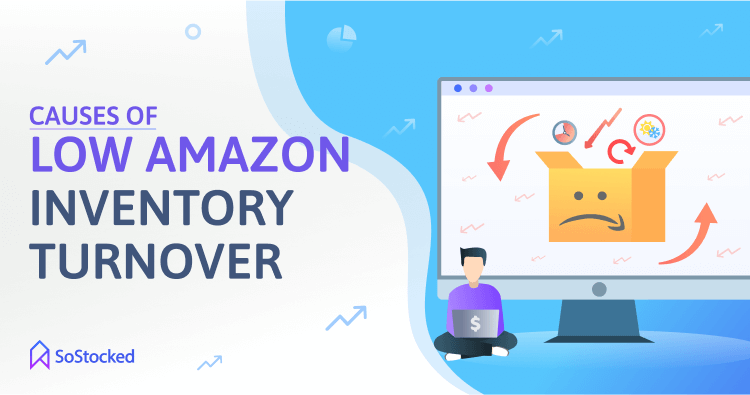
Over-ordering
Excess inventory is often the result of over-estimating customer demand and poor inventory planning. It is expensive to deal with and more difficult to sell through. If the demand for the product declines before you sell all of the units, you either have to put them on sale or discontinue production. Not only does this contribute to a lower ITR, but it also ties up capital and costs you in storage fees.
Weak marketing and sales strategies
Ineffective marketing and sales efforts can also contribute to a low inventory turnover rate. Marketing is a method for building brand awareness and persuading customers to hit that “Buy Now” button. If you’re getting clicks but no conversions, some element or elements of your offer are not working.
One possible reason is that you don’t know enough about your target audience. Are you highlighting the problems your product solves for customers? What makes your product stand out from the competition?
Market research is the first step in building a solid marketing strategy. When you neglect market research, you’ll miss valuable insights that will help you understand your customers and competitors better. Simply put, a lack of proper market research can result in useless marketing projections, which means generating leads that aren’t relevant to your business.
Seasonality
The demand for many products depends on seasonal patterns like festivals and weather. For example, you’ll see that the demand for sleeveless tops peaks during summer due to the hot weather, while leather jacket sellers will see sales spike in the winter.
You’ll also see a significant bump in sales during national holidays like Thanksgiving, Halloween, Christmas, and New Year. If you overestimate demand forecasts for these seasonal patterns, you could end up with excess stock when demand declines. If that stock is not sold through quickly, it can remain unsold for months afterward, affecting your ITR negatively.
Pro Tip: Use an inventory forecasting software program that factors in seasonality to get accurate demand forecasts. Learn how to automate Amazon inventory forecasting.
Poor reordering processes
If you don’t have an automated restocking system, you may struggle to increase efficiency and minimize your order cycle times, making it extra challenging to improve your ITR. Moreover, without methods that can help you optimize your inventory, you may find it difficult to keep track of your stock levels, let alone what and when you should be purchasing next.
Products at the end of maturity phase
Your inventory turnover ratio will change as the products in that inventory move through their life cycles. For example, at the early growth stages, the demand for it could be high, resulting in high ITR. However, as it nears the end of its maturity stage, the demand will start to plummet, and so will your turnover rate.
The trick is to keep an eye on your product’s life cycle to avoid getting stuck with obsolete stock.
Carrying a large number of slow sellers
Holding a large number of slow-moving products in your warehouse will not only cost you in storage fees but will also lower your inventory turnover ratio. Plus, you’re tying up a significant amount of capital within that inventory, creating cash flow problems that may reduce your ability to financially support other areas of your business like operations and marketing.
To sum it all up, a stock turn ratio lower than the industry benchmark indicates that you’re carrying many slow-selling products that may become obsolete over time. And the longer those products sit in your warehouse, the higher your holding costs will be. These holding costs may include warehouse and logistics fees, insurance, spoilage/breakage losses, the opportunity cost of tied-up capital, and obsolete inventory write-offs.
But it’s not all doom and gloom for you. Below are some top tips to help you recover from the setbacks associated with low ITR.
How To Increase Your Inventory Turnover Ratio
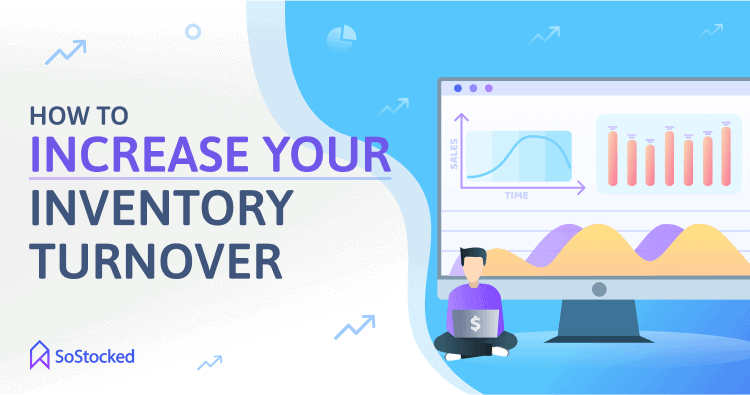
Optimize your inventory
Sort your products from most valuable to least valuable depending on forecasted customer demand, demand volatility, and order frequency (how often you have to replenish a particular inventory). It’s also wise to take note of slow-selling items and take action accordingly to avoid getting stuck with obsolete stock.
Know your SKU’s current stage in the product life cycle
As mentioned earlier, all products go through phases – from introduction, growth, and maturity to decline. Depending on where your product is in its life cycle, it will have different financing, marketing, and manufacturing requirements.
The introduction stage is when you launch a product to the market. Sales are low, and costs are high, so you make little or no profit. And most of the cash is allocated to advertising to create demand.
The growth stage is when your product starts to gain acceptance among target customers, resulting in increased sales.
The maturity stage is when it no longer receives upgrades or new features to advance its growth. Lastly, the decline stage is when it’s clear as day that the product has come full circle, rendering it obsolete.
Knowing where your merchandise is in its product life cycle will give you an idea about improving its position in the market and managing your inventory better.
Improve demand forecasting accuracy
Demand forecasting plays a significant role in inventory management. Accurately forecasting customer demand will help you to figure out:
- Projected sales
- The correct amount of units to reorder
- Timing and frequency of purchasing orders and transfer orders
With valuable insights from your demand forecasts, you’ll be able to make efficient business decisions and reduce threats that may disrupt your cash flow and operations.
However, generating an accurate demand forecast is no easy feat. A good rule of thumb is to have a more sophisticated forecasting technique to predict demand accurately. You can start by identifying trends, adjusting forecasts for seasonality, and removing anomalies like sales spikes and stockouts. But if that sounds like a daunting task, consider utilizing an inventory forecasting software like SoStocked to handle, process, and organize data much better (and faster) than spreadsheets.
In SoStocked, your data is pulled directly from your Amazon account and you can simply plug in any additional data you need to predict demand and optimize your stock levels automatically. You can also include seasonality and marketing plans into your calculations or remove sales spikes and stockouts for improved accuracy.
To learn more about SoStocked, check out our demo page.
Increase reordering efficiency
Ideally, you want to order inventory in small quantities regularly to keep stock turning and minimize costs. But sometimes, life gets in the way, and something unexpected prevents you from reordering on time. That’s where automation comes in.
SoStocked has a min-max restocking feature that allows you to set up a minimum and maximum stock level to stay on top of your inventory levels. The maximum stock will help you minimize holding costs, and the buffer stock will help to prevent stockouts. Once set up, you can train a virtual assistant to help to handle your restocking processes so you can focus on other areas of your business.
For more inventory management tips, click here.
Eliminate unprofitable stock
At a macro level, about 20% of your products generate 80% of your company’s revenue. These products typically have the highest profit margins and the most predictable demand. So many Amazon sellers tend to only focus on their top sellers and not pay much attention to less profitable products. But the longer those other 80% sit in a warehouse, the more it’s going to cost you in storage fees, insurance, breakage losses, and so on.
The best way to handle excess stock or slow sellers is to think of them as a resource or a way to make or regain money and storage space. You can sell them to customers and liquidation companies at discounted prices or bundle them with your other 20%. This way, you can still somehow recoup a certain amount of your investment and use that money to finance your operations.
SoStocked has a Slow-Selling Amazon Product Reporting tool that lets you sort slow sellers or excess stock so you can take action immediately. Consider using it to help improve your turnover ratio.
Implement inventory-minded marketing techniques
Inventory-minded marketing is doing marketing with inventory management in mind or vice versa. This unique strategy addresses the costs associated with stockouts and overstocks. Although they are two different things, both can cost you significantly in financial losses.
How do you minimize costs with an inventory-minded marketing approach?
When you have excess stock, it’s wiser to look at it as an asset that you can re-introduce to the market or liquidate than as a wasted product taking up space and costing you in fees. This approach does not only help you convert excess stock into cash but also reduce holding costs.
Inventory-minded marketing also encourages communication among your inventory and marketing teams. Let’s say your marketing team wants to run an Amazon ad campaign to drive more sales to a product. The campaign succeeds in bringing in a lot of traffic and converting them into sales, but this ends up causing a stockout. Your marketing team can prevent this by checking with the inventory team before starting the campaign to ensure you have sufficient inventory on hand to supply the anticipated demand.
Inventory-minded marketing closes the gap between your inventory and marketing teams, which allows them to work synchronously towards one common goal – growing your business.
Pro Tip: Discover the two inventory-minded marketing tactics that can improve your Amazon marketing campaigns.
Utilize automation to improve insights
Use an advanced inventory management system like SoStocked to track your stock levels at all times. Automation software also provides you with an accurate base to calculate and improve your Amazon inventory turnover ratio. With it, you will be able to extract the data necessary to calculate inventory turns down to ASIN-level, allowing you to identify products that aren’t selling well or providing an adequate return on investment.
Improve Your Inventory Turnover Ratio With SoStocked
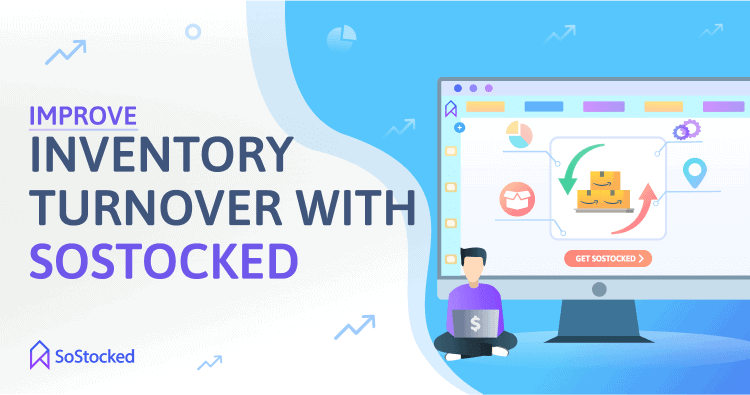
Integrate SoStocked into your inventory management processes to provide the extra level of intelligence you need to increase inventory turnover rates. SoStocked has:
- Customizable KPI dashboards. Choose from a wide variety of seller dashboards that show you an accurate accounting of your inventory in a centralized location. Easily track all shipments, inventory, and projections at all times to spot potential problems like stockouts and overstocks right away.
- Forecast modeling feature. Combine your past sales data and future marketing plans to produce accurate sales forecasts, so you don’t end up ordering too much or too little stock during seasonal events.
- Min-Max Restocking. Set a range for your minimum and maximum days of stock for Amazon FBA and your warehouse to make it easy for you to know how much inventory to order and when.
- Gain valuable insights to inform your future business decisions from SoStocked’s various reporting tools like Stockout Risk Report, Overstock Report, Slow Sales, and Liquidation Report.
- Sync to scale. Implement an inventory-minded marketing approach across your Amazon marketing efforts to improve cash flow and scale your business a lot faster. Build campaigns with your current inventory levels and demand forecasts in mind to avoid stockouts and overstocks.
Convert Inventory Into Cash Frequently
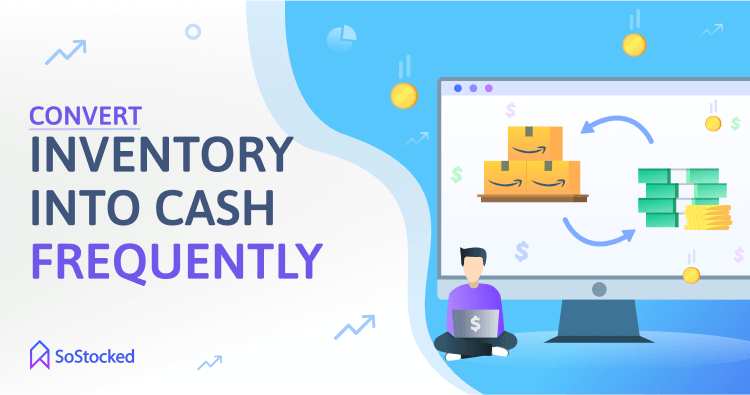
Inventory turnover is an excellent metric to measure your company’s performance. The faster you turnover, the better, as it reflects how well you assess your products’ demand and use the insights from that evaluation to sell them quickly.
However, an exceptionally high turnover rate can be bad for you. It means you encounter stockouts too often or ordering inventory more than usual, and both of those can have negative consequences on your cash flow. That’s why we recommend benchmarking your ITR against other companies in your industry to determine the optimal turnover rate for your business.
Once you’ve done that, you can take action accordingly, whether that means liquidating your slow sellers, doing extensive market research, using automation to improve insights, enhancing the accuracy of your demand forecasts, or implementing inventory-minded marketing tactics.
Need more information?
- Send Message: We typically reply within 2 hours during office hours.
- Schedule Demo: Dive deeper into the nuances of our software with Chelsea.
- Join Live Upcoming Webinar: New to Amazon inventory management? Learn three inventory techniques you can implement right away.
 Start Your Free Audit
Start Your Free Audit